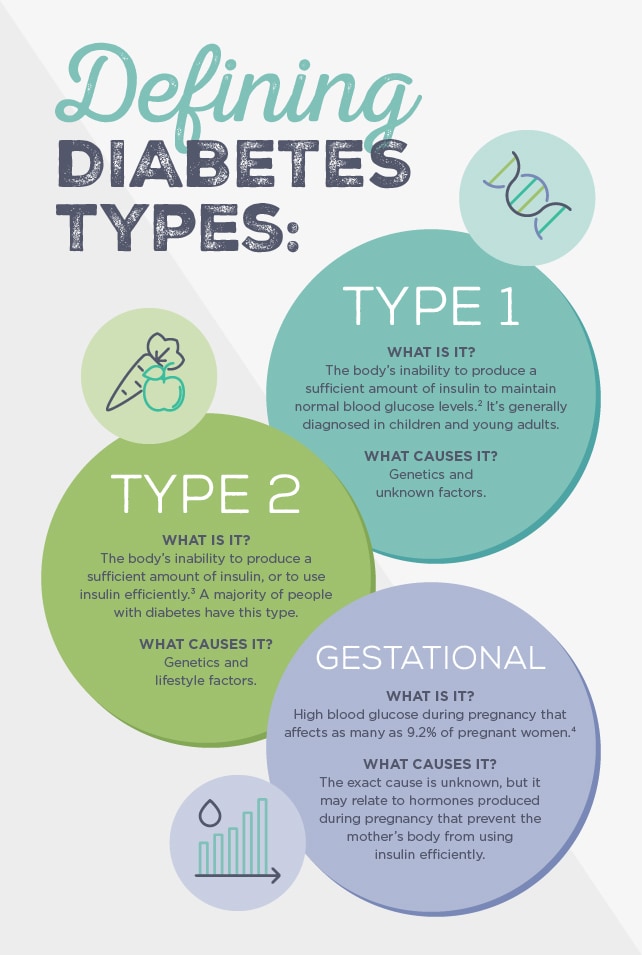More than 30 million Americans currently live with diabetes. One of the most challenging aspects of managing this disease is determining what to eat. Since there’s not a one-size-fits-all eating pattern for diabetics, meal planning should suit individual needs.1
Publix is committed to helping customers and their family members navigate ways to manage diabetes and dispel myths regarding food and lifestyle choices. Let’s start with a look at the different types of diabetes.


Myth 1: Diabetics have to eat different foods than the rest of the family.
Fact: People living with diabetes often can eat the same foods—in moderation—as the rest of the family. Current nutrition guidelines for diabetes are flexible and offer many choices, allowing people with diabetes to fit in favorite or special-occasion foods.5
Winning Strategies for Eating Together
Eating balanced meals with a variety of foods is a good strategy for the whole family. Plan meals that are low in saturated fats, moderate in salt and added sugars, and incorporate whole fruits, vegetables, whole grains, heart-healthy fats, and lean proteins.5 Then everyone can enjoy a treat here and there. Be sure to check with your physician or registered dietitian nutritionist about a meal strategy that’s right for you.
Learn more about eating smart to manage your diabetes risk and shifting your shopping habits to make wise choices.
Myth 2: You cannot eat sweets if you have diabetes.
Fact: People with diabetes can eat desserts as part of their total daily carbohydrate and calorie counts. Controlling blood sugar levels is, once again, all about balance.5
Try these tips to help you and family members enjoy sweets during the holidays and other special occasions.
Dessert Instead of Carb. Work a sweet treat into your meal plan by replacing a small portion of dessert for another carbohydrate. For example, if you want a brownie for dessert, leave out the dinner roll or potatoes from the main course. Remember that most sweets contain a lot of calories and carbohydrates in a small serving, so be sure to watch portion sizes.6
Sugar Substitutes. Replace added sugar with sugar substitutes1 such as sucralose, aspartame, and stevia, which provide fewer calories and have less impact on blood sugar.7 For baked goods, Publix Granulated Sucralose-Based Sweetener or Stevia-Based Sweetener make better choices because they are more heat-resistant.8
Carb Smart Desserts. Check out Publix Aprons Carb Smart dessert recipes, which contain 30 grams or less of total carbohydrates. Pumpkin-Apple Bars make a delicious choice for holiday parties and gatherings.
Myth 3: You cannot eat bread, pasta, or rice if you have diabetes.
Fact: Diabetics can eat carbohydrates in moderation. It’s important to monitor the amounts and types of carbohydrates consumed each day, since these foods impact blood sugar levels the most.5
Here are three easy ways to manage your carbohydrate intake:
1. Manage portion sizes. Check out these handy tips for portion sizes.
2. Work in whole grains. Opt for whole grain versions of breads, pastas, cereals, and rice. Whole grains have more fiber, which may help you feel full and satisfied after eating. Discover more whole grain benefits.9
Our Publix Aprons Carb Smart Berry Oat Bake or Breakfast Pita Flatbreads are satisfying breakfasts that incorporate whole grains and help keep portions in check.
For lunch or dinner, try our family-friendly Publix Aprons Grilled Chicken and Vegetable Bowl, our Cowboy Chicken and Rice, or our Sriracha Garlic Chicken with Corn and Peach Rice Quinoa Blend recipes that include whole grains and veggies.
3. Try lower-carb substitutes. Zucchini noodles (or zoodles) and riced vegetables are great alternatives for higher-carb pasta and rice. Find them in the Produce and freezer sections at Publix.
Our Publix Aprons Spanish Chicken and “Rice” Bowl features a riced cauliflower vegetable medley. Don’t miss out on our Pork Chili Rancho with riced cauliflower, and our Lentil Bolognese over Zoodles.
Myth 4: Diabetics can eat all the fat they want.
Fact: While it’s true that fat does not affect blood sugar, it is still a nutrient to monitor in your diet. High intake of saturated fat can cause the LDL (bad) cholesterol to increase, which may be associated with an increased risk of coronary heart disease. People with type 2 diabetes are already at an increased risk for coronary heart disease.10
The 2015–2020 Dietary Guidelines for Americans recommends less than 10 percent of calories from saturated fat—about 22 g/day for a 2000-calorie diet. Get the skinny on watching your fat intake.
Myth 5: People with type 2 diabetes need to lose a lot of weight.
Fact: A person who has diabetes and is overweight or obese does have an increased risk of complications.11 Yet a modest loss of 5–10% of body weight—that’s 10–20 lb for a 200-lb person—may improve blood sugar control, blood pressure, and cholesterol levels. Taking small steps toward eating better and getting more exercise can help you achieve modest weight loss. Find helpful tips for making changes here.
While some diabetics worry that exercise increases their risk for hypoglycemia, or low blood sugar, the fact is that moderate exercise is a great way to manage blood sugar levels and reduce the risk for heart disease and stroke.12 Be sure to check with your doctor before starting a new diet or exercise program.
Moving Forward
Striking a balance between diet, exercise, lifestyle, and medication is the key to success in managing diabetes. Publix is here to help you along the way with helpful recipes and tips from our registered dietitian nutritionists.
Sources
1 American Diabetes Association. “Lifestyle Management: Standards of Medical Care in Diabetes—2018.”
American Diabetes Association: Diabetes Care. January 2018.
2 American Diabetes Association. “Type 1 Diabetes.” Accessed August 13, 2018.
3 American Diabetes Association. “Type 2 Diabetes. ” Accessed August 13, 2018.
4 American Diabetes Association. “What is Gestational Diabetes?” November 21, 2016.
5 American Diabetes Association. “Diabetes Myths.” July 5, 2017.
6 American Diabetes Association. “Fitting in Sweets.” October 16, 2017.
7 U.S. Food & Drug Administration. “High-Intensity Sweeteners.” May 19, 2014.
8 American Diabetes Association. “Using Sugar Substitutes in the Kitchen.” January 31, 2014.
9 American Diabetes Association. “Types of Carbohydrates.” March 9, 2015.
10 American Heart Association. “The Skinny on Fats.” April 2017.
11 American Diabetes Association. “Weight Loss.” Accessed August 13, 2018.
12 Mayo Clinic. “Diabetes and exercise: When to monitor your blood sugar.” December 1, 2015.

 You are about to leave publix.com and enter the Instacart site that they operate and control. Publix’s delivery and curbside pickup item prices are higher than item prices in physical store locations. Prices are based on data collected in store and are subject to delays and errors. Fees, tips & taxes may apply. Subject to terms & availability. Publix Liquors orders cannot be combined with grocery delivery. Drink Responsibly. Be 21. For prescription delivery, log in to your pharmacy account by using the Publix Pharmacy app or visiting
You are about to leave publix.com and enter the Instacart site that they operate and control. Publix’s delivery and curbside pickup item prices are higher than item prices in physical store locations. Prices are based on data collected in store and are subject to delays and errors. Fees, tips & taxes may apply. Subject to terms & availability. Publix Liquors orders cannot be combined with grocery delivery. Drink Responsibly. Be 21. For prescription delivery, log in to your pharmacy account by using the Publix Pharmacy app or visiting 
